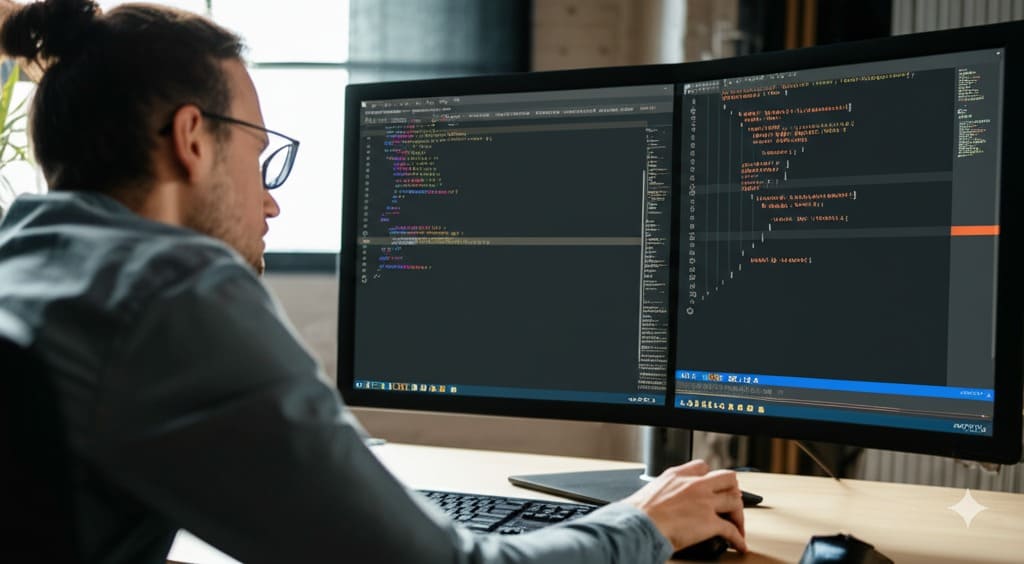
Today, let’s talk about something that’s been buzzing in the software development world lately: Vibe Coding.
Honestly, when I first heard the term, I felt a mix of excitement and maybe a little dread.
Is coding becoming less about logic and more about… feelings?
I remember back in the day, spending literal hours trying to perfectly center a simple box on a webpage with CSS.
It felt like wrestling a particularly stubborn octopus.
Fast forward to now, and the idea is you could just… tell an AI, “Hey, make this look good and center the dang box!” and poof, it happens. Wild, right?
This whole concept, vibe coding, feels like a massive shift brewing in how we create software, especially as we cruise through 2025.
It’s powered by Artificial Intelligence, and frankly, it’s changing the game for developers like me and maybe you too.
We’re moving away from typing every single semicolon and bracket. Instead, we’re focusing more on the big picture, the overall vibe of what we want to build, letting the AI handle the nitty-gritty details.
What Exactly is Vibe Coding?
So, what’s the deal with “vibe coding”?
Dream, just imagine describing what you want your software to do in plain English, just like talking to a colleague.
You explain your goals to a Large Language Model (LLM) – that’s a fancy term for a powerful AI – and it spits out the actual code.
Computer scientist Andrej Karpathy apparently coined the term back in February 2025.
He talked about “giving into the vibes, embracing exponentials, and forgetting that code even exists”.
Now, that sounds pretty radical compared to traditional programming!
The key idea here isn’t just using AI to help write code.
AI researcher Simon Willison put it nicely: if an AI writes all your code, but you carefully review, test, and understand every line, that’s just using an AI assistant.
Vibe coding is different. It often means accepting the AI’s code without necessarily diving deep into how it works.
Our role shifts from being the person meticulously writing the instructions to being more like a director guiding the AI.
How Does Vibe Coding Work? (The Workflow)
Thinking about trying it? The process looks quite different from the old ways:
- Describe Your Goal: You start by explaining what you need in simple, conversational language. No complex jargon required.
- AI Generates Code: The AI takes your description and produces the first draft of the code. It builds the structure and basic functions.
- Refine Through Chat: You then chat with the AI, like a back-and-forth conversation, to tweak and adjust the code until it’s closer to what you envisioned.
- Automated Debugging (Sometimes): Hit an error? Often, you can just paste the error message back to the AI, and it tries to fix itself. Less head-scratching for you!
- Accept and Use: Once you’re happy with the result, you take the final code and integrate it into your project.
Tools like Cursor Composer are even making this multimodal, letting you use voice commands.
Karpathy mentioned he “barely even touch[es] the keyboard” sometimes. Feels pretty futuristic, doesn’t it?
Why All the Buzz? The Rise of Vibe Coding
This trend didn’t just pop up overnight, though it feels like it exploded in early 2025.
It gained enough traction to land in the Merriam-Webster Dictionary as a “slang & trending” noun by March 2025. Pretty fast!
It builds on earlier ideas.
Karpathy predicted back in 2023 that “the hottest new programming language is English,” hinting that AI would reduce the need for specialized coding languages.
We’re seeing that happen now. There’s a big push towards voice-to-code programming, where developers speak their ideas and AI turns them into reality.
Tools like Cursor are prime examples of this.
Naturally, this rapid rise sparks debate. Developers, companies, and educators are asking big questions:
- Is the code reliable, given AI limitations?
- Can we build whole, complex applications this way without major issues?
- Is this just a passing fad, or a fundamental skill we all need to learn?
The Good and The Not-So-Good: Advantages & Limitations
Like any new technology, vibe coding comes with its own set of pros and cons. Let’s break them down.
Advantage: Super Speed and Productivity
Wow, the speed increase is probably the biggest win here.
Generating complex or repetitive code can take seconds instead of hours or days.
Some venture capitalists noted that developers can get “the first 75% [of a feature] trivially” using AI.
Think about building prototypes – what might have taken weeks before can now potentially be roughed out in mere hours.
This allows for incredibly fast testing and iteration.
Advantage: Coding for Everyone (Democratization)
Vibe coding seriously lowers the barrier to entry for creating software.
People with zero traditional programming background can now potentially build functional tools just by describing their needs naturally.
AI researcher Harry Law pointed out how satisfying it can be for a total beginner to build something functional in just an hour.
This opens doors for entrepreneurs, designers, and experts in other fields to bring their ideas to life digitally.
Concern: Understanding and Code Quality
However, there are significant concerns. Relying on code you don’t fully understand can be risky. Subtle bugs or security holes might slip through the cracks.
Karpathy himself admitted that AI tools aren’t perfect and sometimes struggle to fix or even grasp certain bugs.
Long-term maintainability is another question mark. If a codebase grows large and was built mostly through “vibes,” making future changes or fixing deep-seated issues could become a nightmare, especially if it’s beyond the original developer’s “usual comprehension”.
Other Limitations to Consider
Beyond the big ones, developers need to be aware of several potential drawbacks:
- Logical Errors: AI might generate code that looks right but contains subtle logic flaws, leading to hard-to-find bugs.
- Performance Issues: AI often prioritizes getting the code working over making it efficient. This can result in slow or poorly scaling applications.
- Security Vulnerabilities: AI doesn’t inherently think like a hacker. It might produce code with security weaknesses that human developers, with an adversarial mindset, might catch.
- Code Bloat: You might end up with unnecessarily complex or verbose code, making the application larger and harder to manage.
- Lack of Documentation: The quick, conversational nature often means minimal documentation gets created, making it tough for others (or future you!) to understand why things were built a certain way.
- Team Chaos: Without clear planning, having multiple people “vibe code” on the same project can lead to conflicting code, duplicated effort, and design issues.
- Technical Debt: Taking shortcuts via vibe coding can pile up technical debt – problems that need fixing later, potentially slowing down future development.
- Architectural Rigidity: Early design choices made quickly via AI might become hard-coded, making it difficult to adapt or refactor the system later on.
Here’s a quick table summarizing the main trade-offs:
| Advantages | Disadvantages / Concerns |
|---|---|
| 🚀 Dramatic Speed Increase | 🤔 Code Quality & Understanding |
| 🌍 Lowers Barrier to Entry | 🐛 Logical Errors & Bugs |
| ✨ Enhances Creativity & Focus | 🐌 Potential Performance Issues |
| ⏱️ Rapid Prototyping | 🛡️ Security Vulnerabilities |
| 🗣️ Accessibility (Voice/NL) | bloated Code & Maintainability |
| 💰 Potential Cost Efficiency | 📝 Lack of Documentation |
| 🤝 Team Coordination Issues | |
| 📉 Technical Debt Accumulation | |
| 🧱 Architectural Rigidity |
Where is Vibe Coding Making Waves? (Best Use Cases)
Despite the concerns, vibe coding is proving useful in several areas.
Hobby Projects and Quick Prototypes
This is a natural fit. Individuals and hobbyists are using vibe coding to whip up cool projects fast.
Someone built a restaurant menu translator app overnight just by talking to an AI via Cursor.
It’s fantastic for personal automation, trying out ideas, or building small tools without getting stuck on coding details.
Startup MVPs and Product Development
Startups need to move fast. Vibe coding helps them accelerate building Minimum Viable Products (MVPs).
A generative AI startup, Menlo Park Lab, reportedly uses vibe coding for its products, like one that turns PDFs into video presentations.
Getting to market quicker can be a huge advantage, especially for founders who are experts in their domain but not necessarily expert coders.
Web and App Development Helpers
Even seasoned developers like me can find value here. You can use vibe coding for common, somewhat tedious tasks.
Need a standard web form, basic database operations (CRUD), or styling for a user interface?
You could prompt the AI, “Create a responsive navigation bar with a dropdown menu,” get the basic HTML/CSS/JS, and then tweak it.
This hybrid approach can really speed up development cycles.
Spicing Up UI/UX Design
Interestingly, some developers are using vibe coding almost like collaborating with a digital designer. Asking the AI to “make this page look insanely beautiful” can result in better color choices, spacing, or typography than the developer might have come up with alone.
It’s like having an AI design partner on call.
Quick Scripts for Data Analysis
Vibe coding isn’t just for building apps. Analysts, scientists, and others who aren’t full-time software engineers are using it too.
An economist could ask for a Python script to “Import this CSV of sales data, calculate year-over-year growth, then plot it,” and get functional code using libraries like pandas and matplotlib.
It extends the power of coding for task automation and analysis into many fields.
Looking Ahead: The Future of Vibe Coding
Where is all this heading? The rise of vibe coding suggests some significant changes might be on the horizon for programming, development processes, and even how we teach tech skills.
Entering the Enterprise World
Vibe coding isn’t just for hobbyists and startups anymore. It’s starting to creep into larger, more formal enterprise settings.
Platforms like Gitpod are integrating these capabilities into cloud development workflows for professional teams.
Imagine AI agents handling routine bug fixes or generating standard boilerplate code, freeing up engineers to focus on complex architecture and business problems.
Spreading Across Industries
We’re also seeing industries that aren’t traditionally software-heavy adopting these techniques.
Think finance or accounting, where someone might describe a process to an AI assistant and get help generating financial reports or performing real-time calculations.
Vibe coding could become a more general professional skill, not just one for software developers.
Shaking Up Education
This trend definitely makes us rethink technical education.
If programming becomes more about directing an AI, maybe educational programs need to shift focus.
Less emphasis on memorizing syntax, perhaps, and more on system design, effective prompt engineering (talking to the AI well), and AI collaboration skills.
Computer science curriculums and professional training might need a serious update.
Final Thoughts
Vibe coding clearly represents a major turning point in how we build software.
It dramatically lowers the barrier for new creators, offers incredible speed boosts, and fundamentally changes the role of the developer.
I have to admit, the potential is exciting.
However, we can’t ignore the valid questions surrounding code quality, security, long-term maintenance, and the depth of understanding needed, especially for critical systems.
These are challenges the industry needs to grapple with seriously.
Will vibe coding completely replace traditional coding?
Probably not entirely. I suspect it will find its place as a powerful tool alongside existing methods.
Its ultimate impact depends on how the AI technology continues to evolve, how educational systems adapt, and how we collectively learn to balance the amazing productivity gains with the potential pitfalls.
One thing feels certain, though: the “vibe” has definitely shifted, and the world of software development in 2025 and beyond looks quite different because of it.
We’re all learning how to navigate this new landscape together.






